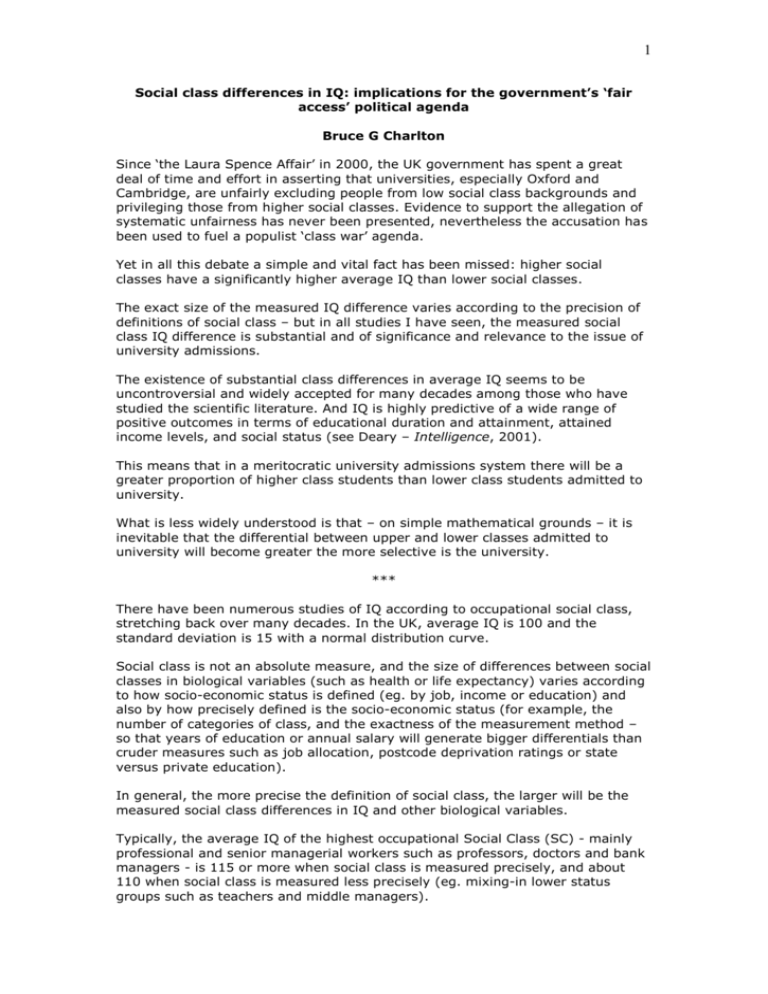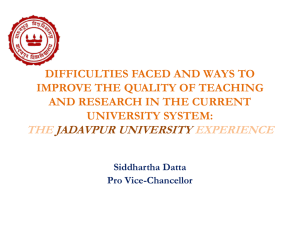Read Bruce Charlton`s full report here
advertisement

1 Social class differences in IQ: implications for the government’s ‘fair access’ political agenda Bruce G Charlton Since ‘the Laura Spence Affair’ in 2000, the UK government has spent a great deal of time and effort in asserting that universities, especially Oxford and Cambridge, are unfairly excluding people from low social class backgrounds and privileging those from higher social classes. Evidence to support the allegation of systematic unfairness has never been presented, nevertheless the accusation has been used to fuel a populist ‘class war’ agenda. Yet in all this debate a simple and vital fact has been missed: higher social classes have a significantly higher average IQ than lower social classes. The exact size of the measured IQ difference varies according to the precision of definitions of social class – but in all studies I have seen, the measured social class IQ difference is substantial and of significance and relevance to the issue of university admissions. The existence of substantial class differences in average IQ seems to be uncontroversial and widely accepted for many decades among those who have studied the scientific literature. And IQ is highly predictive of a wide range of positive outcomes in terms of educational duration and attainment, attained income levels, and social status (see Deary – Intelligence, 2001). This means that in a meritocratic university admissions system there will be a greater proportion of higher class students than lower class students admitted to university. What is less widely understood is that – on simple mathematical grounds – it is inevitable that the differential between upper and lower classes admitted to university will become greater the more selective is the university. *** There have been numerous studies of IQ according to occupational social class, stretching back over many decades. In the UK, average IQ is 100 and the standard deviation is 15 with a normal distribution curve. Social class is not an absolute measure, and the size of differences between social classes in biological variables (such as health or life expectancy) varies according to how socio-economic status is defined (eg. by job, income or education) and also by how precisely defined is the socio-economic status (for example, the number of categories of class, and the exactness of the measurement method – so that years of education or annual salary will generate bigger differentials than cruder measures such as job allocation, postcode deprivation ratings or state versus private education). In general, the more precise the definition of social class, the larger will be the measured social class differences in IQ and other biological variables. Typically, the average IQ of the highest occupational Social Class (SC) - mainly professional and senior managerial workers such as professors, doctors and bank managers - is 115 or more when social class is measured precisely, and about 110 when social class is measured less precisely (eg. mixing-in lower status groups such as teachers and middle managers). 2 By comparison, the average IQ of the lowest social class of unskilled workers is about 90 when measured precisely, or about 95 when measured less precisely (eg. mixing-in higher social classes such as foremen and supervisors or jobs requiring some significant formal qualification or training). The non-symmetrical distribution of high and low social class around the average of 100 is probably due to the fact that some of the highest IQ people can be found doing unskilled jobs (such as catering or labouring) but the lowest IQ people are very unlikely to be found doing selective-education-type professional jobs (such as medicine, architecture, science or law). In round numbers, there are differences of nearly two standard deviations (or 25 IQ points) between the highest and lowest occupational social classes when class is measured precisely; and about one standard deviation (or 15 IQ points) difference when SC is measured less precisely. I will use these measured social class IQ differences of either one or nearly two standard deviations to give upper and lower bounds to estimates of the differential or ratio of upper and lower social classes we would expect to see at universities of varying degrees of selectivity. We can assume that there are three types of universities of differing selectivity roughly corresponding to some post-1992 ex-polytechnic universities; some of the pre-1992 Redbrick or Plateglass universities (eg. the less selective members of the Russell Group and 1994 Group), and Oxbridge. The ‘ex-poly’ university has a threshold minimum IQ of 100 for admissions (ie. the top half of the age cohort of 18 year olds in the population – given that about half the UK population now attend a higher education institution), the ‘Redbrick’ university has a minimum IQ of 115 (ie. the top 16 percent of the age cohort); while ‘Oxbridge’ is assumed to have a minimum IQ of about 130 (ie. the top 2 percent of the age cohort). *** Table 1: Precise measurement of Social Class (SC) – Approx proportion of 18 year old students eligible for admission to three universities of differing minimum IQ selectivity Ex-poly - IQ 100 Redbrick - IQ 115 Oxbridge IQ 130 Highest SC– av. IQ 115 84 percent 50 percent 16 percent Lowest SC– av. IQ 90 25 percent 5 percent ½ percent Expected SC diff 3.3 fold 10 fold 32 fold 3 Table 2: Imprecise measurement of Social Class (SC) – Approx proportion of 18 year old students eligible for admission to three universities of differing minimum IQ selectivity Ex-Poly - IQ 100 Redbrick - IQ 115 Oxbridge - IQ 130 Highest SC –av. IQ 110 75 percent 37 percent 9 percent Lowest SC –av. IQ 95 37 percent 9 percent 1 percent Expected SC diff 2 fold 4 fold 9 fold *** When social class is measured precisely, it can be seen that the expected Highest SC to Lowest SC differential would probably be expected to increase from about three-fold (when the percentages at university are compared with the proportions in the national population) in relatively unselective universities to more than thirty-fold at highly selective universities. When using a more conservative assumption of just one standard deviation in average IQ between upper (IQ 110) and lower (IQ 95) social classes there will be significant differentials between Highest and Lowest social classes, increasing from two-fold at the ‘ex-poly’ through four-fold at the ‘Redbrick’ university to nine-fold at ‘Oxbridge’. In other words, according to social class definitions, the average child from the highest social class is from nine-to-thirty times more likely to qualify for admission to a highly selective university than the average child from the lowest social class. Naturally, this simple analysis is based on several assumptions, each of which could be challenged and adjusted; and further factors could be introduced. However, the take-home-message is simple. When admissions are assumed to be absolutely meritocratic, social class IQ differences of plausible magnitude lead to highly significant effects on the social class ratios of students at university when compared with the general population. Furthermore, the social class differentials inevitably become highly amplified at the most selective universities such as Oxbridge. Indeed, it can be predicted that around half of a random selection of kids whose parents are among the IQ 130 ‘cognitive elite’ (eg. with both parents and all grandparents successful in professions requiring high levels of highly selective education) would probably be eligible for admission to the most-selective universities or the most selective professional courses such as medicine, law and veterinary medicine; but only about one in two hundred of kids from the lowest social stratum would be eligible for admission on meritocratic grounds. In other words, with a fully-meritocratic admissions policy we should expect to see a differential in favour of the highest social classes relative to the lowest social classes at all universities, and this differential would become very large at a highly-selective university such as Oxford or Cambridge. The highly unequal class distributions seen in elite universities compared to the general population are unlikely to be due to prejudice or corruption in the admissions process. On the contrary, the observed pattern is a natural outcome of meritocracy. Indeed, anything other than very unequal outcomes would need to be a consequence of non-merit-based selection methods. 4 Selected references for social class and IQ: Argyle, M. The psychology of social class. London: Routledge, 1994. (Page 153 contains tabulated summaries of several studies with social class I IQs estimated from 115-132 and lowest social classes IQ from 94-97). C.L. Hart et al. Scottish Mental Health Survey 1932 linked to the Midspan Studies: a prospective investigation of childhood intelligence and future health. Public Health. 2003; 117: 187-195. (Social class 1 IQ 115, Social class V IQ 90; Deprivation category 1 – IQ 110, deprivation category 7 – IQ 92). Nettle D. 2003. Intelligence and class mobility in the British population. British Journal of Psychology. 94: 551-561. (Estimates approx one standard deviation between lowest and highest social classes). Validity of IQ – See Deary IJ. Intelligence – A very short introduction. Oxford University Press 2001.









